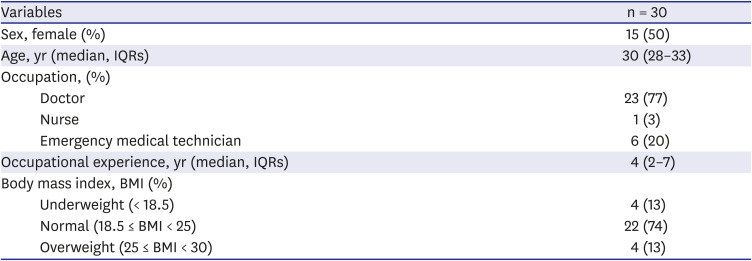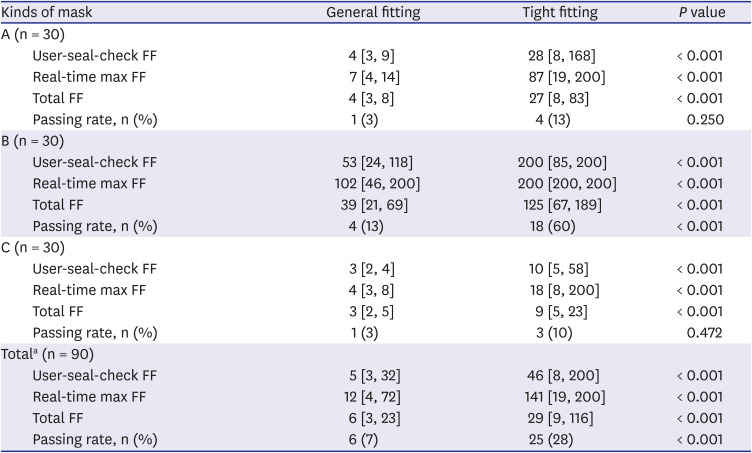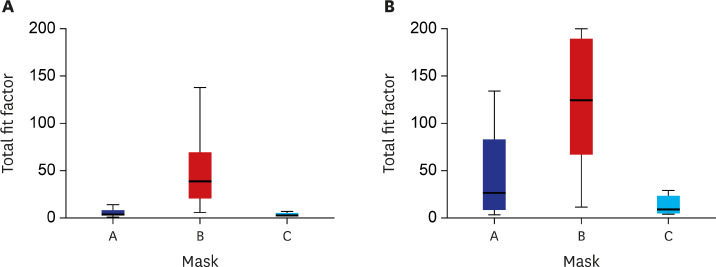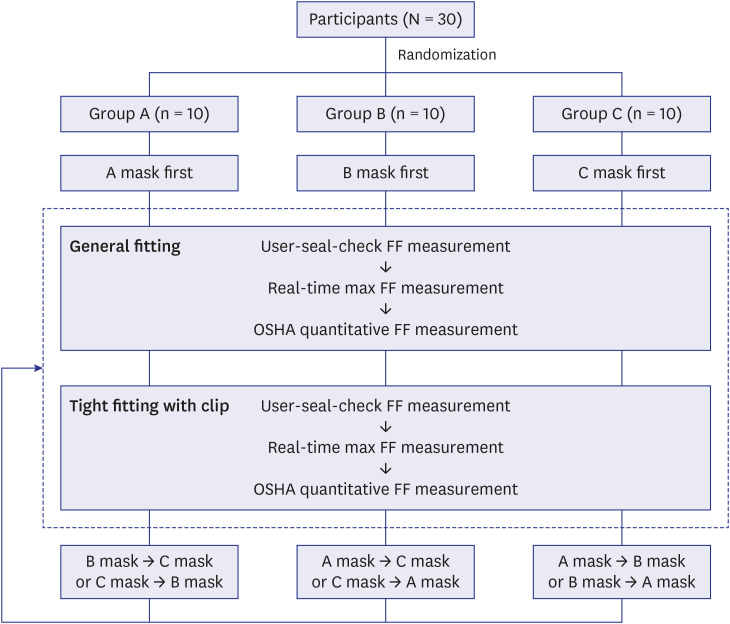INTRODUCTION
Infection prevention and control measures are important for the safety of patients, healthcare workers (HCWs), and the community worldwide during the coronavirus disease 2019 (COVID-19) pandemic. The World Health Organization (WHO) currently recommends droplet and contact precautions for HCWs caring for patients with COVID-19 and airborne precautions for settings where aerosol generating procedures or support treatment are performed.
1 For airborne precautions, it is recommended to wear a particulate respirator with at least National Institute for Occupational Safety and Health (NIOSH) certified N95 respirators (N95), European Union (EU) standard filtering facepiece 2 (FFP2), or an equivalent level of protection.
1
Filtering facepiece respirators (FFRs) are labeled according to national regulations for filtering efficiency. Given the global shortage of N95 during the COVID-19 pandemic, the Korean filter 94 (KF94) mask was recommended for respiratory protection in Korea for situations involving any contact with suspected or confirmed COVID-19 patients under the guidelines of the Korea Center for Disease Control and Prevention (KCDC).
2 Korean standards follow European standards (EN149:2001), and are classified as KF80, KF94, and KF99, similar to the European standards FFP1, FFP2, and FFP3, according to their filtering efficiency (80%, 94%, and 99%, respectively) (Supplementary Table 1).
34
However, in addition to the filtration efficiency, such FFRs can provide adequate protection only when the face seal fits tightly throughout the actual work process.
56 Therefore, the National Institute of Occupational Safety and Health (NIOSH) recommends conformance tests for wearers every year.
7 Also, fit tests should be used to identify respirators that suit best each individual and include training on how to best fit the masks prior to use.
8 However, since KF94 masks are generally used among HCWs without undergoing fit tests, the adequacy of respiratory protection is uncertain.
The KF94 masks use ear loops instead of an elastic head-band as in N95s. In our pilot tests, most of KF94 masks failed to fit properly when undergoing the occupational safety and health administration (OSHA) fit test protocol. The general fitting applied through ear loops may be weaker than a head-band, and this can be a severe concern that hinders mask fitting. Some people who wear ear-loop masks apply a mask clip that connects the ear loops behind the head to reduce pain around the ears. The use of this clip may also increase tension on the entire mask through additional tension on the ear loops; thus, it was reasoned that using a clip may improve the face seal of ear-loop-type masks.
Currently, there are no NIOSH-approved FFRs with ear-loop designs.
9 Furthermore, no study has assessed the adequacy of respiratory protection of ear-loop-type FFRs using a randomized design. Therefore, we aimed to evaluate the fitting performance of ear-loop-type KF94 masks by the quantitative fit test (QNFT) according to the OSHA protocol. In addition, by quantitatively comparing the “tight-fitting” method using a clip and the “general-fitting” method, we tried to evaluate whether the tight-wearing method improves the fitting performance of KF94 masks.
RESULTS
All 30 participants completed the study. Of these, 15 (50%) were women; the median age was 30 years (IQR, 28–33). Most participants were doctors (77%, n = 23), with an average clinical experience of 4 (2–7) years. Most participants (74%) had a normal body mass index (
Table 1).
Table 1
Demographics

|
Variables |
n = 30 |
|
Sex, female (%) |
15 (50) |
|
Age, yr (median, IQRs) |
30 (28–33) |
|
Occupation, (%) |
|
|
Doctor |
23 (77) |
|
Nurse |
1 (3) |
|
Emergency medical technician |
6 (20) |
|
Occupational experience, yr (median, IQRs) |
4 (2–7) |
|
Body mass index, BMI (%) |
|
|
Underweight (< 18.5) |
4 (13) |
|
Normal (18.5 ≤ BMI < 25) |
22 (74) |
|
Overweight (25 ≤ BMI < 30) |
4 (13) |
The total FF of the QNFT according to the wearing method was significantly higher for the tight-fitting method with a clip for all masks (
P < 0.001). However, the total FFs of KF94 masks were very low, with a median of 6 (IQR, 3–23) and 29 (9–116) for general and tight fitting, respectively. FFs after user-seal-check and real-time adjustment increased significantly when KF94 masks were worn tightly for every mask type (
P < 0.001). Regarding passing rates (FF ≥ 100), it was increased significantly from 4 (13%) to 18 (60%) after tight-fitting of only the horizontal 3-fold mask with adjustable ear-loop length (
Table 2,
Fig. 3).
Table 2
FF comparison by wearing methods

|
Kinds of mask |
General fitting |
Tight fitting |
P value |
|
A (n = 30) |
|
|
|
|
User-seal-check FF |
4 [3, 9] |
28 [8, 168] |
< 0.001 |
|
Real-time max FF |
7 [4, 14] |
87 [19, 200] |
< 0.001 |
|
Total FF |
4 [3, 8] |
27 [8, 83] |
< 0.001 |
|
Passing rate, n (%) |
1 (3) |
4 (13) |
0.250 |
|
B (n = 30) |
|
|
|
|
User-seal-check FF |
53 [24, 118] |
200 [85, 200] |
< 0.001 |
|
Real-time max FF |
102 [46, 200] |
200 [200, 200] |
< 0.001 |
|
Total FF |
39 [21, 69] |
125 [67, 189] |
< 0.001 |
|
Passing rate, n (%) |
4 (13) |
18 (60) |
< 0.001 |
|
C (n = 30) |
|
|
|
|
User-seal-check FF |
3 [2, 4] |
10 [5, 58] |
< 0.001 |
|
Real-time max FF |
4 [3, 8] |
18 [8, 200] |
< 0.001 |
|
Total FF |
3 [2, 5] |
9 [5, 23] |
< 0.001 |
|
Passing rate, n (%) |
1 (3) |
3 (10) |
0.472 |
|
Totala (n = 90) |
|
|
|
|
User-seal-check FF |
5 [3, 32] |
46 [8, 200] |
< 0.001 |
|
Real-time max FF |
12 [4, 72] |
141 [19, 200] |
< 0.001 |
|
Total FF |
6 [3, 23] |
29 [9, 116] |
< 0.001 |
|
Passing rate, n (%) |
6 (7) |
25 (28) |
< 0.001 |
Fig. 3
Total fit factors of general fitting (A) and of tight fitting (B) for the 3 KF94 masks.
A: horizontal 3-fold mask, B: horizontal 3-fold mask with adjustable ear loops length, C: vertical 2-fold mask.

When comparing the types of KF94 masks, the total FFs for general-fitting and tight-fitting of masks A, B, and C (median, IQR) were 4 (3–8), 39 (21–69), 3 (2–5), and 27 (8–83), 125 (67–189), and 9 (5–23), respectively. The type B mask with adjustable ear-loop length had a significantly higher FF, while the vertical 2-fold type C mask had a significantly lower FF in both wearing methods (
Table 3).
Table 3
FF comparison by mask type

|
Variables |
KF94 mask |
P value |
|
A |
B |
C |
A vs. B |
A vs. C |
B vs. C |
|
General fitting |
|
|
|
|
|
|
|
User-seal-check FF |
4 [3, 9] |
53 [24, 118] |
3 [2, 4] |
< 0.001 |
0.003 |
0.001 |
|
Real-time max FF |
7 [4, 14] |
102 [46, 200] |
4 [3, 8] |
0.001 |
0.019 |
< 0.001 |
|
Total FF |
4 [3, 8] |
39 [21, 69] |
3 [2, 5] |
0.001 |
0.001 |
0.001 |
|
Passing rate, No. (%) |
1 (3) |
4 (13) |
1 (3) |
0.333 |
a
|
0.333 |
|
Tight fitting |
|
|
|
|
|
|
|
User-seal-check FF |
28 [8, 168] |
200 [85, 200] |
10 [5, 58] |
0.001 |
0.223 |
< 0.001 |
|
Real-time max FF |
87 [19, 200] |
200 [200, 200] |
18 [8, 200] |
0.003 |
0.302 |
< 0.001 |
|
Total FF |
27 [8, 83] |
125 [67, 189] |
9 [5, 23] |
0.001 |
0.014 |
0.001 |
|
Passing rate, No. (%) |
4 (13) |
18 (60) |
3 (10) |
0.001 |
> 0.999 |
0.001 |
There were two events of mask slipping during the test with the mask with an adjustable ear-loop in tight-fitting.
DISCUSSION
KF94 masks are broadly used and recommended in Korea as universal masks for the COVID-19 pandemic. However, there have been no quantitative studies on the fitting performance considering inward leakage. In this study, the FFs of the tight-fitting method with a clip were significantly higher in all recorded variables for every mask type, including the user-seal-check FF, real-time monitored maximum FF, and total FF (P < 0.001). However, the tight-fitting median FF was 29, which was still lower than 100, the OSHA fit test passing criteria. That is, the ear-loop-type KF94 masks did not provide sufficient tension, so the face seal was not maintained with movement. Therefore, this study proved that KF94 masks with ear loops cannot provide adequate respiratory protection when dealing with highly contagious patients, such as those with COVID-19, in a healthcare setting.
However, these results are not specific to KF94 masks. In a study on the fitting performance of 10 types of N95, 54% of the participants were not adequately protected by any of the FFRs tested.
12 Additionally, a more recent study found that the fit test passing rates of four N95s were below 50%.
13 In a simulation study using a manikin, it was found that a poorly fitting N95 had a 30% lower infectious virus blocking rate than a tightly fitting respirator, and did not show any beneficial effect compared to unsealed surgical masks.
14 Therefore, the above mentioned studies showed that it is not easy to properly wear FFRs. On the other hand, one study demonstrated that the fitting performance was increased by approximately 50% after training in FFR wearing.
12 In our study, the FFs were significantly increased in all masks during self-mask adjustment after the user-seal-check. Furthermore, although the type B mask showed the highest FF in most of the participants, a small number of participants showed a better fit with other mask types. Therefore, it is important to choose a suitable FFR for each individual and learn how to wear the mask tightly in advance, preferably with a fitting test.
During the COVID-19 pandemic, studies have been conducted on how to improve the mask fit of various FFRs considering the global shortage of N95s. Han et al.
15 introduced a tight fitting net in their study, which consisted of a flexible plastic net connected to the strap, which covers the exterior surface area around the filtering media, and found that it significantly increased the fitting performance. For medical procedure masks, modifications that enhanced the fit between the mask and the wearer's face, that is, simply tying the ear loops and tucking the corners of the mask against the wearer's cheeks, visibly improved the mask fit and increased the filtration efficiency from 38.5% to 60.3%.
16 Furthermore, sealed surgical masks using adhesive medical tape led to a marked reduction (60–98%) in inward leakage of aerosols in all participants.
6 However, complex modifications of the mask and the wearing method may not be used much because it is difficult to apply these interventions in the actual workplace. In this study, the FFs of all ear-loop-type KF94 masks increased significantly when wearing tightly with a simple modification using a clip. In particular, face seal adjustable KF94 mask had a significantly higher FF in both general and tight wearing methods, and its FF and QNFT pass rate increased significantly when using the clip. Therefore, our study showed that the fitting performance of an ear-loop-type mask can be properly maintained when the mask is more tightly fitted to the face, which occurs when more tension is applied through the ear loops by adjusting the ear-loop length or using a clip.
Even if the N95s become more accessible, KF94 masks are preferred in general healthcare settings in Korea. The important factors when choosing a mask type are not only safety but also the comfort of wearing the mask, especially if prolonged wearing is needed. In a study on long-term use of N95, blood CO
2 levels of nurses became significantly elevated and many subjective symptoms, such as perceived exertion, dyspnea, headache, and lightheadedness also increased over time compared to beginning-of-shift baseline measures.
17 Over time, touching or non-fitted wearing of FFRs due to discomfort can be a major factor that hinders adequate respiratory protection of HCWs. Considering that the clip used in this study were originally designed to improve wearing comfort by relieving pain behind the ears, especially in prolonged wearing, the results indicate not only a more comfortable but also a safe way to use ear-loop-type KF94 masks.
For one participant with a beard, the FFs of all masks were extremely low (below 10), and there was no significant change even with the clip. This proves once again the importance of adjusting the mask to the face, and it is better to remove the face-seal area hair when wearing FFRs, according to the CDC recommendation for facial hairstyles and FFRs.
18 Furthermore, when the fit test was performed after tight-fitting of the adjustable ear-loop mask, there were two cases when the ear loops connected to the clip slipped and the mask became loose. This may be a disadvantage of wearing a head-strap type mask. In N95 donning, downward slippage of the top strap off the crown of the head is a relatively frequent occurrence with general use, leads to a negative impact on the fit and, by extension, on the protection afforded to the wearer.
1920 When the ear-loop-type KF94 mask is tightly connected with a clip, it is necessary to check in advance if there is any slipping after head movement and adjust the mask according to the hairstyle. Eliminating factors that interfere with the facial seal and proper wearing of respirators are paramount to minimize the risk of infection.
In this study, we demonstrated that an adequate face seal cannot be achieved with ear-loop-type KF94 masks. However, our results suggest that selected adjustable models of ear-loop-type FFRs modified using a clip can provide significantly improved respiratory protection over general ear-loop masks. Therefore, if the FFRs labeled according to their own national regulations are of the ear-loop type, a modified fitting, such as using clips or adjusting the ear-loop length, is indicated to increase the mask-face seal. In addition, to improve the respiratory protection of HCWs during the COVID-19 pandemic, it is important to choose a suitable FFR for each individual and teach them how to wear the mask tightly through a fit test in advance.
Our study had certain limitations. First, we used only three KF94 types with ear loops of different shapes; thus, these may not be representative of all KF94 masks or all ear-loop-type masks, and there is a limit to generalize the results. Furthermore, although KF94 masks with filtration efficiency certified by the KFDA were used, comparison with N95 or EU FFP2 was not carried out. Thus, it is difficult to draw conclusions regarding the effectiveness of respiratory protection compared to that of these masks. Second, the total FF of QNFT was measured only once according to the wearing method for each mask per participant. Even if the participants wear the same mask, in the same way, the FF may change for each test, limiting the interpretation of the results due to the single-measure design. Third, QNFT was conducted according to the OSHA protocol consisting of some activities, which might differ from the actual clinical activities. Moreover, the QNFT conducted within 3 min cannot guarantee whether the protective effect will be maintained during prolonged use. Forth, after general-fitting QNFT measurement of each mask, masks were not changed during tight-fitting QNFT measurement, which may have affected the results. However, the FFs of the tight-fitting method were significantly higher in all measurements for every mask type, thus it does not seem to be a meaningful change. Fifth, in addition to the wearing method, we did not consider related factors, such as face size and presence of a beard, that interfere with mask fitting. Sixth, we did not assess the user experience of KF94 masks according to the wearing methods and mask types. Finally, we did not consider the expediency and infection risk associated with the donning and doffing of masks.
In conclusion, even with sufficient filter efficiency, KF94 masks with ear loops do not provide adequate protection. However, in relatively low-risk environments, wearing a face-seal adjustable KF94 mask and tight wearing with a clip can improve respiratory protection for HCWs.








 PDF
PDF Citation
Citation Print
Print






 XML Download
XML Download